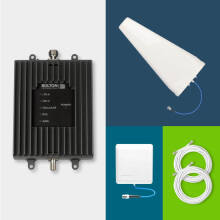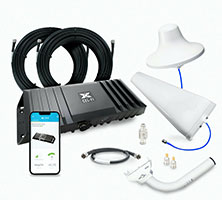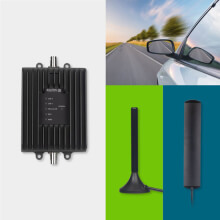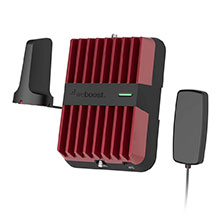10 Tips and Tricks to Improve Your 5G, 4G and LTE Data Speed
Making the most of your cellular signal and increasing your 5G, 4G, and LTE data speeds can really make a difference in everyday life. More and more people are using 4G LTE or 5G as a primary internet connection, so getting the fastest speeds is essential. A lot contributes to slow data speeds — building materials, mountains, weather, distance, and more. In this blog, we will give you some top tips and tricks on how to make cellular data faster.
Take advantage of our system design and installation services. Learn more or call us for a free consultation: 1-800-969-8189.
What Is the Best Way to Boost 5G or 4G LTE Data Speed?
We’ve all been there. Your favorite song is streaming through the speakers, about to reach its crescendo, and just as you’re belting out the high notes at the top of your lungs — boom — radio silence. Buffering, ugh. Your best answer to poor signal no matter where you are is a cell phone signal booster.
Whether you're using super-fast 5G for home internet, keeping in touch via 4G LTE on the road or running your own office, there is a cell phone signal booster for every unique situation.
While there are some simple hacks to make a phone work a little more efficiently, a proper cell signal amplifier is the ONLY way to strengthen — and speed up — your signal. For any 4G or 5G -enabled devices at your disposal, signal boosters are the #1 most reliable and efficient way to keep them working at top speed, guaranteed.
It's important to remember that 5G is only used for cellular data right now. If you are making phone calls and using voice, it’s always done over 4G LTE. Dropped calls are usually caused by bad 4G LTE signal. This can also be fixed by using a cell signal booster, also called a cell signal amplifier.
Why Is My 5G or 4G LTE Cell Data Slow?
There are various reasons why you may have slow data speeds.
- Signal quality: Even if you have good bars, you may still struggle with slow LTE data speeds. This is because your actual signal QUALITY is low. The best way to fix this is to get a good outdoor antenna and connect it to a signal booster.
- Signal strength: Of course, the fewer bars you have, the worse your data speeds will be. It may not be the biggest reason for slow cell internet speeds, but it is an important one.
- Signal qualityOf course, the fewer bars you have, the worse your data speeds will be. It may not be the biggest reason for slow cell internet speeds, but it is an important one.
- Too many apps: If you have loads of apps open on your phone or if you have lots of devices connected to your cellular home internet your connection speed can slow down. Close or turn off anything you aren't currently using.
- Network congestion: Just like a busy highway, if the network has lots of people all trying to get good 5G or LTE data speeds it may get clogged. If you are in a highly populated area it’s likely that your nearest tower has a high traffic volume.
- Data throttling: Some carriers and plans implement throttling if your data usage is too high. This is where they specifically slow your internet speeds to reduce your data usage. Look for a plan that offers “unthrottled” data.
Tips And Tricks To Speed Up Mobile Data On Your Phone:
1. Keep Your Battery Full
Signal-searching can drain batteries when the connection is weak, so maintaining the fullest charge can help to keep your phone in working order. Unfortunately, battery life does not directly impact the strength of the signal you receive, but it does help to keep the phone actively searching and performing at peak efficiency.
2. Get Outside
If you’re able to access an open window, balcony, rooftop, or yard — then get exploring. Building materials like metal, concrete, and even glass can interfere with 4G LTE signals — which are great at travelling great distances, but not so great at travelling through or around obstacles. If you’re not glued to a single spot, finding a space with limited obstructions (or removing said obstacles, if possible) can help your chances of clear reception, especially if you can locate your newest cell phone tower. Apps like OpenSignal and RootMetrics can help to find the strongest signal near you.
3. Clear Your Cache
Cached data on your phone are saved documents, images, or other files that have been downloaded and stored in temporary storage. This data can help your phone to open apps and webpages faster, but too much of it causes sluggishness. To blast the bloat, you need to clear your cache regularly.
To clear the cache on an Android phone:
- Open the Chrome app or your chosen browser
- At the top right, tap More or Settings
- Tap History and then Clear browsing data
- At the top, choose a time range. To delete everything, select All time. (Not all browsers have this step)
- Next to "Cookies and site data" and "Cached images and files," check the boxes.
- Tap Clear data.
To clear the cache on an iPhone:
- Open the Settings app
- Find Safari
- Tap Clear History and Website Data
- Confirm the prompt
4. Get a New Device
Outdated phones or hotspots are often not able to run at optimal speeds, and many can't use 5G. Upgrading to the latest technology will make sure that you get the most out of the cellular network.
5. Clear Out Clutter
A lightning-fast signal won’t help your phone’s efficiency if the device itself is slowed down by clutter. Regularly clear out the cache on your internet browser, close out background apps that aren’t currently in use, and delete any apps that you don’t use to ensure that your cell phone is running at peak efficiency. It also helps to check for updates so you can be sure that you’re running the most recent version of your smartphone’s software.
6. Switch Carriers
Your current cell phone service provider could be the culprit. If you suspect that another carrier might provide better service in your area, it might be worth the switch. Cell phone signal boosters work with all US carriers, so finding the right booster is easy.
7. Switch Browsers
Most phones come with a pre-loaded browser. This browser may not be the best choice for you. Some browsers have a Lite version, for example, Opera Mini, that uses less data and can help to speed up your cell connection.
8. Select Your Carrier
Some phones have their network setting on automatic. That means that it switches between carriers depending on roaming status and where you are. Setting your phone to only use your chosen network can make your data speed faster.
9. Close Your Apps
Having apps running in the background can use bandwidth. It's always a good idea to close apps that you aren't using, especially if they use data. Social media apps are particularly known for slowing data speeds if they are open all the time.
10. Turn It Off and Back On Again
Every IT professional ever can’t be wrong. Before you get discouraged, try turning off your device and restarting it. Also, consider switching your phone to airplane mode for 5 seconds, then switch back. Sometimes all it takes is a quick reboot to work out the kinks in any electronic device — even your smartphone.
How To Use 5G For Home Internet
5G can provide fast and easy home internet. It offers data speeds fast enough for streaming, online gaming, and downloading. 4G LTE will also work as a permanent internet option. It’s readily available, cheap, and fast enough to run a home or office internet connection.
To make use of 5G or 4G LTE for home internet you need a cellular router and a data contract with a SIM card from a carrier. Once you have got these, a signal booster will ensure you have the fastest connection.
For even more boost, get a powerful outdoor antenna, and you’ll never look back.
Our Best Cellular Home Internet Routers
Peplink MAX BR1 Pro 5G
- Multi-Core CPUs
- 5G to WiFi 6 cellular modem
- 800% faster speeds than the original BR1 Classic
The Peplink MAX BR1 Pro 5G is a slightly more budget-friendly option than the BR2 Pro. It also offers gigabit speeds and 5G to WiFi 6 but has half the ports. It is faster than the BR1 Cat 20 where 5G is available and steady. If there is no 5G, it will use 4G or LTE. Either way, the BR1 5G offers a real alternative to a cabled ISP connection.
Peplink MAX BR1 Mini
- 100 Mbps download speed
- Multiple connection options
- Good for home WiFi
- Comes in 50 Ohm or 75 Ohm
- Choose from CAT7, CAT6, LTE/WiFi, and pure LTE Models. DC and AC power
Tips And Tricks To Speed Up Mobile Data for Home Internet:
1. Move your Router
Cellular routers need to be in an area of good signal. If you only have the small antennas that the router comes with you need to position it carefully. Don't put it away in a cupboard or on a bookshelf. If your internet data speed is slow, consider moving your router to an area with better signal.
2. Use a Signal Booster
Just like your phone, your cellular router needs a good signal to be at its fastest. If you have poor signal inside your building or home your router likely won't be fast enough. Using a signal booster will ensure that you have a good, steady cell signal where you need it most. A MIMO router allows for upload and download data streams at the same time, increasing your data speeds.
Below are our top cell signal booster recommendations, for homes and vehicles.
Our Top Home Cell Signal Booster Kit Recommendations
Bolton Victory Yagi/Panel Cellular Signal Booster
Overview of the Bolton Victory Yagi/Panel:
- For Small to Medium Size Homes and Offices
- Covers Up to 4,000 Sq Ft
- Up to +72 dB Gain
- Up to 26 dBm Uplink Power
- Supports All Carriers Simultaneously
The Bolton Victory Yagi/Panel cellular booster is our top pick for rural areas. Under optimal conditions, it can blanket up to 4,000 sq ft with stronger cell reception, which is more than enough for most people. Featuring up to 26 dBm uplink and up to 72 dB gain, it has incredible reach and can significantly amplify your existing weak cellular signal.
Strategically paired with the Bolton Quicksilver Outdoor Yagi Antenna, it works wonders in remote locations. This antenna is designed to draw in signals from cell towers up to 5 miles away. Distance from the signal source will no longer be a problem.
While capable of boosting multiple carriers at the same time, you may only receive improved cell reception from one or two carriers. This is because the antenna is directional and needs to point at the closest cell tower that’s powered by your preferred carrier. If boosting multiple carriers is more important than coverage area, consider the Bolton Velocity Omni/Panel Cellular Signal Booster.
| Pros: | Cons: |
|
|
Cel-Fi by Nextivity GO X
Overview of the Cel-Fi GO X:
- For Large Homes and Offices
- Covers Up to 15,000 Sq Ft
- Up to +100 dB Gain
- Amplifies One Carrier at a Time
The GO X by Nextivity is the most powerful cell phone signal booster for remote areas available. It’s designed with up to 100 dB gain, the highest on the market. This unit can seriously make all your signal woes disappear. The caveat is that it can only boost one carrier at a time. Though, through the Cel-Fi WAVE app, you’re able to switch between carriers as you need.
Super customizable, you have multiple outdoor antenna options to really maximize the amplifier's reach to your closest cell tower. You can reach cell towers located up to 5 miles away with the Quicksilver Yagi, up to 10 miles away with the Bolton Arrow LPDA, or up to 20 miles away with the Bolton Long Ranger. No matter how weak your cellular reception is, any of these configurations will keep you connected, that is unless you’re in a total dead zone.
Rated to cover up to 15,000 sq ft, it's best for large homes and small businesses. Indoor coverage will vary based on the strength of your outside signal.
| Pros: | Cons: |
|
|
SureCall Flare 3.0
Overview of SureCall Flare 3.0:
- For Small Homes or Spot Coverage
- Covers Up to 3,000 Sq Ft
- Up to +72 dB Gain
- Up to 26 dBm Uplink
- Supports All Carriers Simultaneously
- 2-in-1 Amplifier/Indoor Antenna Combo for Ease of Installation
The SureCall Flare 3.0 cellular booster packs a signal punch for the price. It includes a Yagi antenna, which is ideal for rural areas, and a sleek amplifier. The indoor antenna is built into the amplifier, making the Flare 3.0 one of the easiest units to install yourself.
With up to 72 dB gain and 26 dBm uplink, it offers good amplification and reach to distant cell towers for a booster of its kind. While power is similar to that of the Bolton Victory, the Flare 3.0 offers less coverage and a less powerful Yagi antenna. It’s rated to cover 3,000 sq ft, but will likely only provide multi-room to spot coverage.
| Pros: | Cons: |
|
|
Best Cell Phone Boosters for Vehicles
Bolton Velocity Vehicle
Overview of the Velocity Vehicle:
- For Cars, Trucks, and RVs
- Up to 50 dB Gain
- Support Multiple Carriers Simultaneously
- Easy Install
The Velocity Vehicle is carefully crafted to keep drivers and passengers connected in the most difficult environments. It’s built with the highest gain and uplink. No matter where you drive, as long as there is a sliver of cellular signal, the Velocity Vehicle will keep all devices connected.
This particular model comes with a magnet mount antenna, making it ideal for your everyday cars, SUVs, and trucks. Installation is a breeze. For semis and heavier-duty trucks, consider the Velocity Trucker. It includes a tough OTR outside antenna featuring great reach, heavy-duty construction, and whistle-free wrap.
| Pros: | Cons: |
|
|
weBoost Drive Reach
Overview of the weBoost Drive Reach:
- For RVs, Cars, Trucks, and Boats
- Up to 50 dB Gain
- Support Multiple Carriers Simultaneously
- Easy Install
The weBoost Drive Reach is weBoost’s most powerful in-vehicle cell signal booster for cars, SUVs, trucks, and minivans. Features increased uplink than previous generations, users can get signal that is 2x farther from towers for twice the signal strength. Dropping calls and losing navigation connection will all be a thing of the past while driving on remote roads or highways.
Cellular antennas will vary depending on the Drive Reach configuration that best meets your needs.
We wouldn't recommend anything weaker than the Drive Reach for rural areas.
| Pros: | Cons: |
|
|
3. Update Your Firmware
Cellular routers use firmware to function correctly. Think of it like an operating system. Keeping your firmware up to date will improve internet speeds and make your connection more secure. Update your firmware from your router’s admin app or panel.
4. Reset Your Router
When in doubt, turn it on and off again. Unplug the router from its power source, count to ten, and plug it back in again. This resets the router and helps it to find the nearest best signal when it reconnects.
5. Check Connected Devices
Your cellular home internet connection may be being slowed by too many devices. Check your network to see who or what is connected, and disconnect anything that you don't need. Keep an eye out for unwanted users as well as devices.
6. Upgrade Your Router to Use 5G
Just like the most up-to-date cell phone, you also need to have the latest router. Old routers won't be nearly as fast as newer ones and may not be able to use 5G.
7. Don't Stream and Download at the Same Time
If you want to stream a movie or your favorite series, don't download a big file at the same time. This can use up most of your bandwidth and end up causing buffering. Set downloads for late at night when no one is using your internet connection.
8. Turn Off Other Appliances
Microwaves, cordless phones, and other appliances all interfere with cell signals. Turn them off where possible or try to move your router away.
9. Check your Bandwidth Limit
Some cellular data plans come with a bandwidth limit. If you are using one of these then your carrier may be “throttling” your speed. Contact your carrier to confirm your data package and switch to an unlimited plan if possible.
10. Use the Right Antenna
Outdoor antennas are key for a good indoor signal. They connect to your router or signal booster to get the best possible 5G or 4G signal inside to the inside device. If you are in an area where the signal is weak, having a good donor antenna can improve both signal strength and signal quality. 2X2 MIMO or 4X4 MIMO antennas can complement your MIMO router making 4G LTE or 5G even faster. We have some super MIMO antenna kits like the Bolton Crossbow 5G and the Poynting EPNT-4 5G WiFi antenna.
Our Best Antennas for Fast Cellular Home Internet
Try one of these bad boys to improve your 4G or 5G home cellular internet:
The Crossbow 5G MIMO Antenna by Bolton Technical
- 2X2 High Gain MIMO Antenna
- Ideal for direct connection to a MIMO cellular router, modem, or hotspot
- 5G Capable: Covers 617-3800 cellular frequencies
- Up to +11 dBi of gain
The Bolton Crossbow 5G is everything you need to get better 5G, 4G, and LTE signal. Connect to towers up to 5 miles away, making this antenna the perfect choice for rural or urban areas.
Poynting XPOL-1-5G Omni-Directional MIMO Antenna
- Boost 5G, 4G, and LTE
- Wideband 2x2 or 4x4 MIMO 4G/5G
- Works with all signals and all carriers
- Small, rugged IP65 Case Up to +11 dBi of gain
With the XPOL-1 you can boost all cellular signal within the 617-3800 MHz range with +3.5 dBi gain. It is a great budget option to boost cell signal where you need it most.
Will A Femtocell Boost My Cellular Signal?
Most cellular service providers have released their own versions of the femtocell, which is basically a personal cell phone tower for the home or office. While a femtocell does increase data speed for cell phones, it does so by connecting to a landline internet service, so in-home WiFi is required. Because it uses an existing WiFi connection to convert its signal to cellular, femtocells can clog that connection and slow down the reception for the other WiFi-enabled devices in your home or office, like smart TVs and computers.
Femtocells are carrier-specific, which means that only users on the same service will receive the boosted signal. In addition, femtocells broadcast to all users in the vicinity, so anyone with a carrier-specific phone in your immediate area will benefit from your boost. This means, yes, nearby strangers will get better reception as well — no password required.
Contact Us
If you need info on anything 5G, 4G, LTE, cellular, how to boost your cell signal, or just want to chat about anything signal related we can't wait to hear from you! Give us a shout on 1-800-470-6777 or email sales@signalboosters.com.
Interested in Learning More? Check Out Our Cellular Info Hub / WiFi Info Hub














